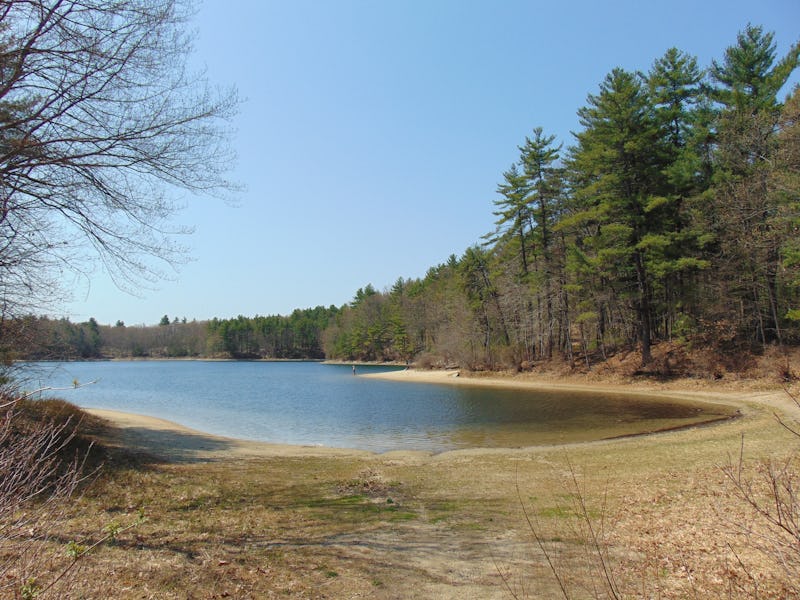Thoreau's Beloved Walden Pond is Being Destroyed by Urinating Swimmers
"I think he would be sorry to see it teetering on the brink of being loved to death."

When Henry David Thoreau’s attempt to simplify his life took him to the shores of Walden Pond in 1845, the Massachusetts reserve was a quiet haven enclosed by tall oaks and pines and wreathed with wild grapevines. Its natural beauty inspired his transcendentalist masterpiece, Walden; or, Life in the Woods, now a mainstay of high school reading lists. But if Thoreau were to return now, a study on Walden published Wednesday suggests, he would be sorely disappointed.
Like so many of America’s once-pristine landscapes, Walden Pond has been transformed by human activity and climate change, says Paul Smith’s College natural sciences professor Curt Stager, Ph.D. and his co-authors in a study published in PLoS One. Since 2015, Stager has been digging into the mud at the bottom of the pond to see how much it’s changed over the course of history. The cores of sediment he and his colleagues have gathered tell a story we’re now all familiar with: Humans have changed the site’s ecology for the worse.
“I do feel some sadness from our findings, but more than that I see our results as a wake-up call,” says Stager in an email to Inverse, noting that an uptick in water-clouding algae has been one of the most dramatic changes he’s observed in his research. “That could set off a vicious cycle of phosphorus enrichment that could turn Walden from a beautiful clear lake into a slimy green stew.”
A species of fibrous green algae known as Nitella is crucial to maintaining the health of Walden Pond.
In previous analyses of the sediment cores, a physical record of the past 1,800 years, the team showed that the clarity and cleanliness of the pond decreased dramatically after humans started visiting the area recreationally, which, ironically, became popular after Thoreau’s book took off. The new study shows that Walden Pond’s ecosystem is changing as well.
While indigenous humans have traversed Walden for thousands of years, tourists started visiting en masse at the turn of the 1900s, taking dips into its iconic pond. Doing so has left its mark on the lake’s muddy floor, which largely consists of layers of dead microscopic organisms like algae and other kinds of phytoplankton. These naturally occurring life forms drift and settle like snowflakes, carrying with them a record of the pond’s chemical changes over time.
Sediment cores from the bottom of Walden Pond recorded 1,800 years of the pond's history.
The nearly two-foot-long cores Stager’s team dug up from the middle of the pond showed how disruptive — and gross — humans can be. An uptick of phytoplankton, beginning in the 1920s, after the shoreline was developed for tourism, suggested that human activity was making the pond more habitable for those organisms. Phytoplankton thrive on phosphorus and nitrogen — which just so happen to be a big part of human waste.
“[Human] wastes, largely from swimmers, now represent about half of the algae-stimulating phosphorus budget of the lake,” Stager says. In Life in the Woods, when Thoreau yearned to “front only the essential facts of life,” he probably wasn’t referring to the fact that humans can’t help but pee in bodies of water.
The phytoplankton “blooms” that result turn the pond cloudy and slimy, which in turn disrupts the rest of the ecosystem. Water-bound photosynthesizing plants require light to grow, but sun can’t filter down through a murky pond. In theory, as those plants die in the dark, the organisms that rely on them for food do too, and so it goes up the food chain. Networks of green algae called Nitella usually trap phosphorus at the bottom of the pond, where other water-muddying algae types can’t reach it, but the excess of phosphorus threatens that balance.
The coring sites were located nearby "Thoreau's Cove," next to the grove of trees where the author built his cabin.
While human swimmers are pegged as the “largest source” of plankton-feeding nutrients now, Stager, who profiles his Walden Pond research in his upcoming book Still Waters: The Secret World of Lakes, predicts that climate change will only make the situation worse. Previous work by study co-author and Boston University biologist Richard Primack, Ph.D., who has been studying Walden Pond’s ecology for years, has already shown that plants, birds, and insects are becoming active earlier than usual because of the shorter winters and that ice melt on the pond happens earlier in the year.
Just as Thoreau saw his experience at Walden as an experiment that could be recreated by all Americans, the ecological situation at Walden Pond applies to the country as a whole. Though it’s unlikely that the pond will ever be restored to its original condition, human intervention is our best bet for preventing further damage, says Stager. Educating swimmers about conscientious pond practices or even installing a public swimming pool nearby, he points out, might stop the pond from becoming even cloudier than it already is. He admits, however, that the pond might become more popular than ever as climate change makes New England summers longer and hotter.
For now, he says, Walden Pond remains “pleasantly clear,” but we must take steps to preserve it the way Thoreau remembered it. When asked how the author might have responded to the changes at Walden, Stager says Thoreau’s feelings would have been mixed.
While he would have been happy to know that people love the pond as much as he did, says Stager, “I think he would be sorry to see it teetering on the brink of being loved to death, and feel regret in knowing that his writings have contributed to that situation by making it so famous that it draws hundreds of thousands of visitors from around the world each year.”